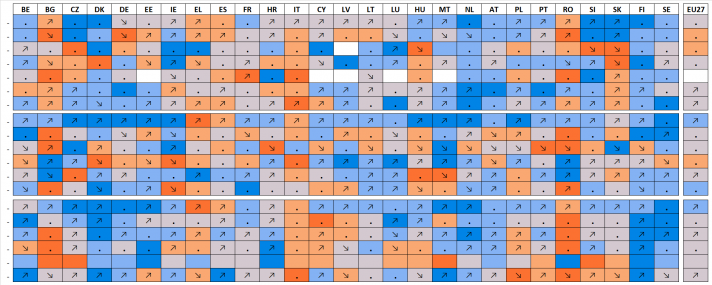The social and economic, green, digital, and geopolitical resilience dashboards
The resilience dashboards provide a holistic assessment of the ability to progress amidst ongoing societal transformations and challenges ahead, across four dimensions
- social and economic
- green (environmental)
- digital
- geopolitical
They have been developed by the European Commission in a process of collective intelligence with Member States and other relevant stakeholders, as a follow up to the 2020 Strategic Foresight Report.
They represent a forward-looking monitoring tool for the transition-led EU policy agenda and aim to help Member States identify areas for further analysis and potential policy actions.
Click here to visit the dedicated webpage
Latest News:
Version Spring 2024
The resilience dashboards have been updated as of Spring 2024. This most recent update is based on data up to 2022 and includes some additional refinements and adjustments to selected indicators, to further align the dashboards with the information set used in the 2024 European Semester Country Reports. For the first time, overall vulnerability and resilience capacity indices are included as proposed in Monitoring resilience in the EU, Benczur et al. (2023).
Resilience Dashboard Spring 2024
Global dashboard Version Summer 2023
The resilience dashboards at global level have been updated as of Summer 2023. This most recent version of the global dashboards is based on data up to 2021. It also includes some additional refinements and adjustments to selected indicators, to further align the Member States dashboards of Spring 2023.
Global Resilience Dashboard Summer 2023
Version Spring 2023
This is the most recent version of the dashboards based on the latest available data. For the first time, each one of the 2023 European Semester Country Reports include a Resilience Annex that is based on the resilience dashboards and discusses results corresponding to the 2023 Spring dashboards’ update.
The Spring 2023 version refers to data up to 2021 and follows the yearly data update that was made in the series at source. Other updates include refinements and adjustments to selected indicators, or replacement of discontinued indicators.
Resilience Dashboard Spring 2023
Version Spring 2022
Besides recent data updates at source as of year 2020, the Spring 2022 version of the dashboards includes refinements and adjustments to selected indicators, eventually leading to a more effective alignment of the dashboards with the information used in the 2022 European Semester Country Reports.
The Spring 2022 report includes an overview of the specific changes at indicator level.
Resilience Dashboard Spring 2022
Version November 2021
This is the original version of the resilience dashboards on its launch, which embodies the technical and policy considerations that were put forward in its inception and during the following public consultation.
Resilience Dashboard November 2021 and its annex
Version July 2021
This draft version of the resilience dashboards was developed by the European Commission in a process of collective intelligence with the Member States and other relevant stakeholders. Both the report and annex were published online for public consultation. This version of the dashboards was audited by the JRC Competence Centre on Composite Indicators and Scoreboards (JRC-COIN).
Prototype dashboards
The 2020 Strategic Foresight Report proposed prototype resilience dashboards aimed to assess the vulnerabilities and capacities of the EU and its Member States in each of the four dimensions, taking a forward-looking perspective informed by strategic foresight.
- Link to Prototype dashboard for monitoring the social and economic dimension of resilience
- Link to Prototype dashboards for monitoring the geopolitical, green, and digital dimensions of resilience

